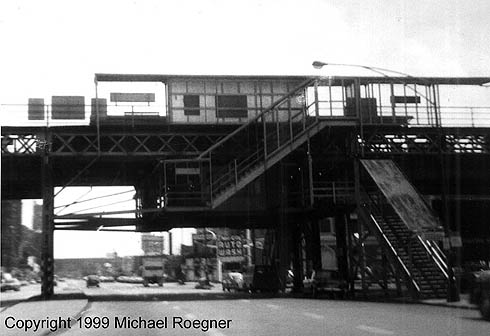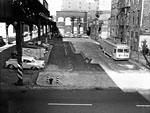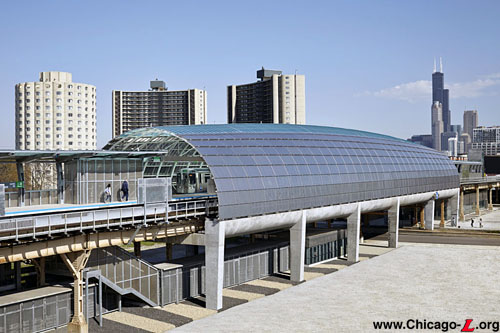
The architecturally distinctive Cermak-McCormick Place station is seen looking northwest on September 17, 2015, with other unique buildings creating a backdrop -- the Hilliard Towers Apartments, designed by Bertrand Goldberg as the Raymond Hilliard Homes housing project, on the left, and SOM's famous Sears Tower (now Willis Tower) in the far right background. Although sometimes casually referred to as being a "tube", the station's characteristic canopy is actually an arched shed supported by a concrete structure. The shed covered the center of the platform and tracks, while the outer portions of the platform, including stairs between the platform and street level, are covered with smaller cantilevered canopies. For a larger view, click here. (Photo by Kate Joyce Studios, courtesy of CDOT) |
Cermak-McCormick Place
(2200S/0E)
Cermak Road and State Street, Near South Side
Service
Notes:

|
Green Line:
South Side Elevated |

|
Accessible
Station |
Quick Facts:
Address: |
12 E. Cermak Road (main entrance, north side of Cermak Rd) |
11 E. Cermak Road (auxiliary entrance, south side of Cermak Rd) |
12 E. 23rd Street (23rd St entrance) |
Established: |
June 6, 1892 |
September 9, 1977 (original station closed) |
February 8, 2015 (new station
opened) |
Original Line: South Side Rapid Transit
Previous Names: 22nd Street, Cermak Road
|
Skip-Stop Type:
|

|
Station
|
Rebuilt: 1907, 2013-15
Status: In Use
History:
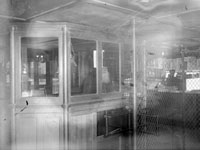
The interior of the 22nd Street mezzanine station house is seen looking inside through the exterior windows in 1907. Note the horizontally-rotating-type turnstile. The decorative ticket agent's booth survived until the station was demolished. For a
larger view, click here [off-site link]. (DN-0004915, Chicago Daily News negatives collection, Chicago History Museum, courtesy of the Library of Congress) |
There have been two stations located at Cermak Road (22nd Street) during the "L"'s history. The first, 22nd Street station, was one of the original "L" stations on the first line built, opened in 1892. This station was modified in 1907, renamed Cermak Road in the street changed its name in the 1930s, and closed in 1977 amid low ridership and a neighborhood in decline. A second station opened nearly 40 years later, in 2015. This larger station was built to serve the McCormick Place convention center, as well as a planned sports stadium for DePaul University, the burgeoning Motor Row entertainment district, and a neighborhood in the process of redevelopment.
Original 22nd Street (Cermak) Station
22nd Street was one of the original ten stations of Chicago's
first "L" line, the South Side Rapid Transit. The original station building
was a grade-level structure built in 1892 with a brick exterior and a
large bay in the center of the front elevation. The station had two
side platforms with short "humpbacked" canopies.
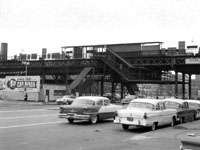
The layout and configuration of the Cermak station can be seen in this view looking southwest in May 1959. Stairs on the south side of Cermak led to the mezzanine station house, which customers passed through, exiting on the north side to stairs up to the platforms, which each had a short, flat-roof canopy. For a
larger view, click here. (CTA photo, Graham Garfield Collection) |
In 1907, as part of an
ordinance to allow the South Side Elevated to install a third track for
express service, all stations north of 43rd
Street, including this one, were required to replace their
grade-level facilities with mezzanine-level stations, clearing the
alley beneath the tracks. Between 18th and 39th Streets, the third track was added on the east side of the existing elevated structure, with the new track becoming the new northbound track and the old northbound track becoming a bidirectional express track. This resulted in the relocation of 22nd's northbound
platform. The replacement of the street-level station house with a mezzanine facility required the the elevated structure to the raised at the station (with grades of up to 1.44% at some stations
to compensate for the change in elevation) as the city ordinance permitting the work required that there had to be sufficient clearance under the mezzanine for vehicles to pass.
The mezzanine station facility was a
fairly simple structure, constructed of sheet metal with simple
ornamentation. Stairs, originally descending north toward the street,
were relocated behind the station after the street was widened. When the new mezzanine station house was built in 1907, it was on the south side of 22nd Street. Later, 22nd Street was widened, with the new width coming from the land along the south side of the street, and the mezzanine ended up being suspended over the new eastbound road lanes. When 22nd Street was renamed Cermak Road in honor of Chicago's assassinated mayor, Anton Cermak, the station's name changed to follow suit.
Over its life,
the Cermak station's usage has fluctuated as its importance changed.
Normally, it was an average station serving a residential
neighborhood and modest commercial strip. But in 1933, to improve its
share of traffic destined for the Century of Progress Worlds Fair
being held in Burnham Park, the Chicago Rapid Transit Company got
temporary permits to run shuttle buses from Cermak and State/Van
Buren to the Exposition, making Cermak a highly-patronized
transfer point.
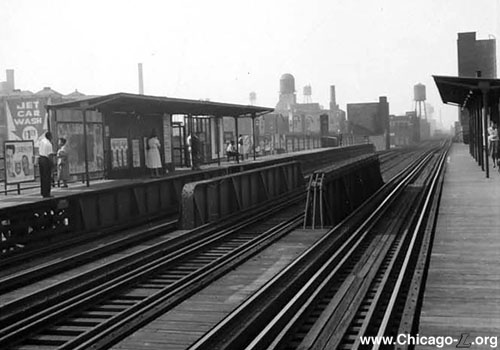
The Cermak station platforms are seen looking north on August 19, 1959. The original hump-shaped canopies were replaced with flat-roof ones, probably when the platforms were reconfigured during construction to add the third track and raise the structure to accommodate the mezzanine station house. The platforms were otherwise very simple, with plain railings and little ornamentation. The center track was not used in regular service at this point, but was still technically in service for another five years. For a larger view, click here. (CTA photo, Graham
Garfield Collection) |
In the CTA's 1949 North-South Route service revision, Cermak became a "B"
station under the A/B skip-stop system due to its relatively low number of users compared to the other stations CTA kept open after the service revision.
In 1960, the CTA embarked on a project to provide an
off-street bus-rapid transit passenger interchange at the station to
expedite the heavy flow of traffic to the new McCormick Place
convention center. An L-shaped parcel on the north side of Cermak Road, adjacent to the east side of the "L" with a driveway extending under the structure to State Street, was identified for the terminal. The purpose of the terminal was primarily for shuttle bus service between the "L" station and McCormick Place. It is unclear, however, if the terminal was ever completed and brought into use, as only a couple years later signs in the station mezzanine instructed passengers, "to McCormick Place / board buses on Cermak at Wabash".
During the postwar era, the
station's patronage remained relatively steady but began to drop in the late 1960s and continued to do so into the 1970s. The changes in ridership were caused in large by changing population densities and demographics in the surrounding area, and was no doubt exacerbated by the Cermak-Chinatown
station opened three blocks away on the Dan Ryan Line in 1969.
With patronage dropping and a need to prioritize resources, the CTA identified Cermak as a station for cost economizing and possible closure. CTA began withdrawing service from the station in the mid-1970s. On September 12, 1976, service at Cermak station reduced to 0530-1900 hours on Monday-Friday and 0600-1900 hours on Saturdays, with the station closed at all other times. On January 8, 1977, service was withdrawn on Saturdays, leaving the station open during daytime weekday hours only. Service was further reduced a few months later when, on May 22, 1977, ticket agent coverage was discontinued weekday middays. Trains continued to stop during middays but to discharge passengers only; passengers could only enter the station during weekday morning and evening period.
Finally, on September 9, 1977, Cermak station closed completely. With Cermak's closure, the gap between stations
on the North-South Route became over 2-1/2 miles, between Roosevelt
and Tech-35th. The station was demolished in 1978.
New Cermak Station Planned, Built
In February 2002, the City and the CTA officially
acknowledged the need for an additional station on the Green Line
between Roosevelt and 35th-Bronzeville-IIT. A 2002 study by the Chicago Department of Transportation examined daily boarding at potential new "in-fill" stations on the Lake Street and South Side main line Green Line branches, including Cermak as well as a number of other locations between Roosevelt and 35th. Of the locations for an intermediate stop that were discussed, the other site most seriously considered was 18th Street, which could serve developing South Loop housing, Soldier
Field, and the Prairie Avenue Historic District, and which has a
crosstown bus line, like Cermak Road.
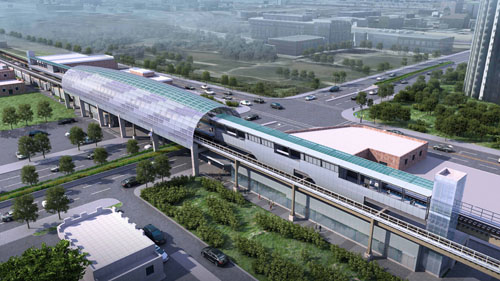
An artist's rendering shows the main entrance to the new Cermak-McCormick Place station, looking north on the north side of Cermak Road. The full-height glass curtain walls of the station house, polished, curved metal canopy over the entrance approach, and stylized street furniture give the facility a decidedly modern feel. For a larger view, click here. (Rendering courtesy of CDOT) |
"Relocating a station [at Cermak] is one of many improvements we're
evaluating throughout the system," CTA
spokeswoman Noelle Gaffney said at the time . "We don't have a cost
to reopen one... We're in the midst of a feasibility study with the
city."
In 2009, CTA was still actively studying and considering the development of an "in-fill" station at 18th or Cermak. A new Green Line station at 18th or Cermak was part of a city planning report submitted to the Regional Transportation Authority on Tuesday, September 15, 2009.
By 2011, Cermak was chosen as the site for the new station over 18th Street. Chicago Transportation Commissioner Gabe Klein said the project is a missing link in the downtown transportation system. "Cermak has three interesting aspects. The existing population needs a stop. There's open land for transit-oriented development. And it can also serve McCormick Place," the commissioner said.1 Jim Reilly, trustee of the agency that operates McCormick Place, the Metropolitan Pier & Exposition Authority, said the new station would offer "tremendous new revenue and business" both for the convention and Navy Pier, which is to get new express bus service partially funded by the congestion tax.2
In Autumn 2011, Chicago Mayor Rahm Emanuel proposed a $2-a-day "congestion fee" on downtown parkers whose proceeds would be used, in part, to fund the construction of a new Cermak Green Line station. The proposed $50 million station would serve McCormick Place, the newly-designated Motor Row entertainment district and a residential population almost certain to grow with more "transit-oriented" development.3 In addition to the new congestion fee, funds for the station would also come from a tax increment financing (TIF) district that covers the Near South Side.4
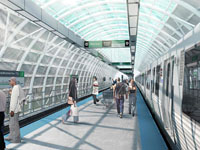
An artist's rendering shows the column-free island platform covered by the full-width shed canopy designed for the Cermak-McCormick Place station. For a larger view, click here. (Rendering courtesy of CDOT) |
At the dedication of the renovated Grand Red Line subway station on January 17, 2012, Chicago Mayor Emanuel announced the City's intention to proceed with several "L" station projects, including construction of a new Green Line station at Cermak, as well as the new Loop station at Washington/Wabash and the rehabilitation of the Clark/Division subway station.5
Design work on the new Cermak station began in March 2012. Construction was set to begin by February 2013 and expected to be complete by July 2014,6 but this timeline was extended. Daniel Burke, acting deputy commissioner for the Chicago Department of Transportation's engineering division, said he expected the first designs for the station would be presented at a community meeting in August 2012, and plans for the station would be finalized five months after that.7 Construction originally had to be completed by the end of 2014 at the latest, when the Near South tax increment financing district, which is at least partially funding the project, was scheduled to expire.8 However, due to harsh, unusually cold weather over the two winters the construction extended through, work wasn't completed until February 2015. The station project cost $50 million.
The station, which allows another access point to McCormick Place, was expected to provide a significant boost to the convention industry and help facilitate conventioneers getting downtown quickly and affordably, as well as spur development and encourage economic development in the surrounding community.9 At the time of the groundbreaking, several development projects were in progress or on the drawing board, including a new Motor Row entertainment district around McCormick Place championed by Mayor Emanuel, anchored by new hotels, restaurants, nightclubs, and a 10,000-seat $173 million DePaul basketball arena that would double as an "event center" for mid-sized shows too large for Navy Pier and too small for McCormick Place.10 At the time of the station opening, city officials and developers said they were optimistic that the new access to rapid transit would help accelerate the expansion of businesses and housing in the South Loop area.11
The station design and construction project was managed by the Chicago Department of Transportation (CDOT).
Station Design
The project's architect was Ross Barney Architects, led by Carol Ross Barney, who designed the unique glass and steel station at Morgan. T.Y. Lin handled the engineering for the design.12
This $50 million project consisted of the design and construction of a new elevated station. The new station is ADA-accessible and has station house facilities located at ground level. Due to the constrained width of the property available for construction, as well as the desire to have multiple access points and the need for at least half of those to be ADA-accessible, the station has a very elongated site plan and layout. These conditions also gave rise to the station's most distinctive design feature.
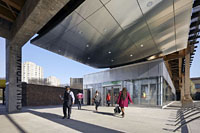
The modern steel and glass main station house of the Cermak-McCormick Place station is seen looking north on September 17, 2015. For a larger view, click here. (Photo Kate Joyce Studios, courtesy of CDOT) |
The station has three entrances -- on the north side of Cermak Road and one on the south side of Cermak, plus a third on the north side of 23rd Street, to the south -- to serve different sets of riders: neighborhood residents; Motor Row patrons and conventioneers walking two blocks over from McCormick Place.13 The station house on the north side of Cermak Road is the main entrance to the station, staffed at all times and featuring the largest footprint and circulation space. The entrances on the south side of Cermak and at 23rd Street were designed to be secondary entrances, using the same style and materials but smaller in scale than the main entrance. All three headhouses feature a modern design, with an exterior of glass curtain walls with perforated metal upper wall panels and a metal coping. All three buildings are set back from the street, with concrete plazas in front with custom-designed bike racks. The plaza in front of the entrance on the south side of Cermak is deeper, and also featured a Divvy bike-sharing station in addition to bike racks when the station opened. CTA "Identifiers" were included in the project, mounted to the elevated structure over the street at Cermak Road and 23rd Street. Each identifier includes a large CTA logo centered on a horizontal pole to attract attention from afar and provide remote identification of the station's location. At Cermak Road, the CTA logo is flanked by bus and train symbols, denoting the transit services available at those entrances, while the identifier at 23rd features only train symbols since there is no connecting bus route there.
The interiors of all three entrances feature full-height windows on all the exterior elevations, while interior walls are clad in dark gray glazed brick. The flooring is light gray granite, while the suspended ceiling is finished in polished metal panels with recessed lighting. The station houses were built where the elevated track structure had already existed for over a century, and rather than modify the structure to locate the support columns out of the way, the buildings were instead built around them, their poking through giving the interiors an industrial feel. All three headhouse interiors feature farecard vending machines, digital screens with train arrival and service information, and transit information panels.
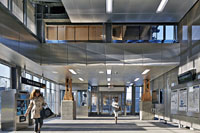
The interior of the Cermak-McCormick Place main station house unpaid area is seen looking south on September 17, 2015. The tiered design of the unpaid area provides an airy feeling from both the high ceiling and the additional light let in from above. For a larger view, click here. (Photo Kate Joyce Studios, courtesy of CDOT) |
The main entrance on the north side of Cermak is the largest of the three entrance buildings. A customer assistant booth is at the front of the interior, in the southeast corner. In the middle of the interior, in front of the turnstiles, the ceiling opens up into a higher, tiered interior with a second level of exterior windows, adding additional daylight inside during the day and providing a more open, airier feel. Beyond the turnstiles, a stairway with a switchback ascends to the platform, while the ground-level interior extends farther back, ending at the elevator to the platform. A second stairway provides exit-only egress from the platform and street level, and while it traverses the interior it does not allow access to the building interior -- between platform and street level, the stairs lead to a mezzanine level with a walkway turnstiles providing a unique overhead view down to the interior unpaid area. From the mezzanine level, a second flight of stairs leads to a passageway along the west side of the interior, barricaded from the unpaid area by a full-height perforated metal panel wall, ending at an exit-rotogate at the street elevation of the building.
The two secondary entrance buildings are smaller versions of the main station house, each slightly different in scale. The auxiliary entrance on the south side of Cermak Road is the smallest of the two, containing only fare controls, space for two fare vending machines, and a transit information board. The 23rd entrance is larger, and in addition to space for three fare vending machines and the information board, includes a customer assistant booth at the front end in the southeast corner and a row of equipment rooms along the west side of the building. The south Cermak entrance was intended to always be unstaffed, but the 23rd entrance was designed to be able to function in either with or without a station attendant. Both entrances only have high-barrier gate (HBG) turnstiles -- unlike other stations where the entrance is meant to be able to function in either staffed or unstaffed modes, no normal turnstiles are provided at the 23rd Street entrance for use during staffed periods. In addition, because the 23rd entrance is accessible but wheelchairs cannot fit in an HBG, a special access door wired into a farecard reader on a turnstile cabinet is also provided. Customers touch their card to the reader like at any other turnstile, then after a few seconds the door automatically opens. Security cameras are provided at the door to try to prevent fare evasion by multiple people going through the door at a time, should the entrance ever be unstaffed. As similar door was installed at the Cermak south entrance, as it was also originally intended to be an accessible entrance. While the door and cabinet were installed, it was decided not to permit entry through this door before the opening, though it could be converted for accessible entry at a later date if desired. The south Cermak and 23rd entrances are connected by a ground-level walkway, located under the elevated track structure, which is largely open to the exterior, enclosed only by full-height perforated metal panels and a roof -- one can freely walk between the two entrances, if desired. Two stairways, one closer to each of the headhouses, and an elevator connect the passageway to the south end of the platform.
The station platform is between the tracks, and its configuration as well as the canopy design is largely owed to the constraints of the site. As described above, the section of the South Side elevated on which the station is located previously had three tracks, with the center track used for peak-direction express trains. Although the center track had been removed from service several decades before, the space between the two in-service tracks remained. To reduce infrastructure and property acquisition needs, the design uses the former center track's space for the platform. However, the center track space only provided enough room for a 14-foot-wide platform, whereas CTA design standards normally requires a 22-foot-wide center platform.14 "It's an extremely tight footprint," explained then-Transportation Commissioner Gabe Klein at the groundbreaking. "The city owns the land immediately around the tracks, but there's no room to build out beyond it. So, we'll be utilizing a center platform."15
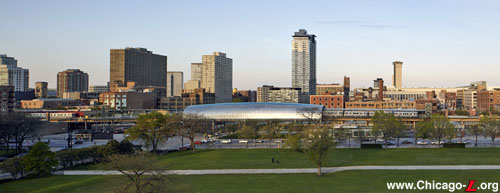
Cermak-McCormick Place's metallic "tube" canopy is seen in its entirety in this wide angle view of the station looking east on September 17, 2015. Also evident is how long the station is at platform level, with lengthy stretches extending out on either side of the shed canopy, owing to the staggered boarding zones on the platform. For a larger view, click here. (Photo Kate Joyce Studios, courtesy of CDOT) |
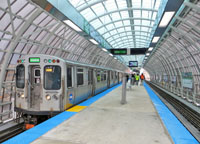
Harlem-bound Green Line Run 608 has just completed its station stop at Cermak-McCormick Place and is preparing to depart on February 9, 2015. The train and platform are completely covered by the station's full-width barrel-vaulted canopy. For a larger view, click here. (Photo by Graham Garfield) |
While Ross Barney Architects didn't set out to design a tube at Cermak-McCormick Place,16 the need to maximize the utility and circulation space of the available width required the designers to make some strategic decisions, leading to the station's most distinctive feature. "The dynamic envelope of the train is such that you can't put any permanent construction [near the platform edge], so in this case there wasn't even room for a bench," said design lead Carol Ross Barney. Weather protection and a wind barrier were necessities, but columns and signage were placed outboard of the track area, leaving the platform column-free and with as few obstructions as possible. "We connected the canopy and wind breaks on the side and we had a tube," said Barney.17
"Because we only had so much space to work with, we decided to keep the platform as open as possible," said Julian Silva, the CDOT architect who managed the station project. "Instead of having wind shelters at the center of the platform, which the CTA typically does, we moved the shelters to the outside of the track, to create this tubelike structure that protects you no matter where you are in the boarding area."18
The result was the signature design element of the station, a tube-like canopy that provides a windbreak for passengers on the island platform. Perforated metal panels on the sides of the 260-foot-long arched canopy, and a row of soft, sage-green-tinted translucent polycarbonate panels down the center of the canopy's apex, allow natural light to filter onto the platform. The station structure is completely independent of the "L" structure, according to Silva.19
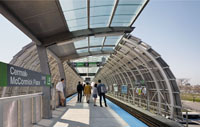
A view looking south down the northern portion of the Cermak-McCormick Place platform on September 17, 2015 shows the platform's transition from the cantilevered-canopy side-loading section to the middle portion dominated by the station's signature vaulted canopy. For a larger view, click here. (Photo Kate Joyce Studios, courtesy of CDOT) |
To further reduce the potential for the platform to become overcrowded, and to create additional passenger amenity space, the train berths in each direction were staggered. The middle section of the platform, covered by the tube-like vault canopy, is approximately 250 feet long, is able to accommodate five cars in each direction. To achieve the additional length needed to accommodate 8-car trains, as to disperse passengers, the platform continues in each direction -- about 175 feet to the north and over 200 feet to the south -- but these sections only face one track, not both. While situated between the tracks, these sections of the platform, which have a back railing facing the un-served track, function more like side platforms. These sections are also weather protected, but feature cantilevered canopies with translucent polycarbonate roof panels similar to those found at a typical side-platform "L" station. These sections contain the stairways between the platform and street-level -- two stairways at each end -- which are pushed against the back railing, to maximize circulation space between the stairs and the platform edge. Elevators bookend each end of the platform.
To maintain as little platform clutter as possible, and achieve a clean, streamlined aesthetic, dual stainless steel raceways suspended by cables over the platform, near the edges, contain a number of important systems -- lighting for the platform, speakers, security cameras, and station name signs. At intervals along the platform, suspended between the raceways are backlit wayfinding signs, digital screens for train arrival and service information, and digital advertising screens.
Inside the arched canopy, approximately every 50 feet a station name sign is mounted to the steel frame of the vault, facing the island platform. Under each of these alternates a static advertising poster panel, a directional line diagram sign for wayfinding, and an art panel. The station name signs continue outside of the tube on the side-facing platform sections, mounted to the canopy supports on the platform and to free-standing frames outside the tracks, opposite the platform; these outboard frames also continue the ad panels and line diagrams.
The station is outfitted with security cameras and illuminated with LED lighting -- the first CTA station to have 100 percent LED lights, which are more energy-efficient than fluorescent tubes.20 The project also included new sidewalks, landscaping and street lights along 23rd Street.21
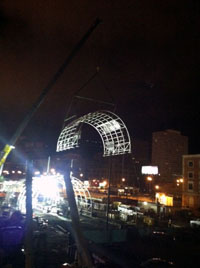
A prefabricated section of steel canopy structure is lifted into place at Cermak-McCormick Place on the night of November 1, 2014. For a larger view, click here. (Photo courtesy of CTA)
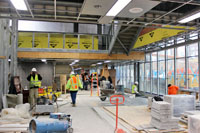
Construction workers work to install the fittings, finishes and equipment inside the main station house at the Cermak-McCormick Place station on December 8, 2014. For a larger view, click here. (Photo by Tony Coppoletta) |
Public art installations were part of the project scope, and take the form of a series of eight panels mounted on the canopy vault structure, outboard of the tracks facing the platform. Chicago-based artist Hebru Brantley was chosen to create the artwork for panels from a pool of artists who presented proposals for the art component of the project. Brantley's vision was to combine art and storytelling, using his signature characters Fly Boy and friends to tell the rich history of Motor Row, where the station is located. With such a large-scale project and installation, the process was several months in the making, and he believes it turned out quite nicely and was grateful for the opportunity to be chosen.22
Station Construction
Mayor Rahm Emanuel, CDOT Commissioner Gabe Klein, CTA President Forrest Claypool, and local officials broke ground on the new Cermak Green Line station on August 29, 2013.23
The City of Chicago issued a construction building permit for the station on October 7, 2013. The general contractor for the project was F.H. Paschen, S.N. Nielsen & Associates.24
Engineers who designed and built the new station said one of the biggest challenges was carrying out the project while Green Line trains were operating.25
Green Line service was suspended for short periods on several weekends during the construction period to allow work such as lifting and setting steel and doing other work very close to the tracks. Nearly all of these closure were during mornings only, from the beginning of service until 11:40am, sometimes just one day on a weekend, sometimes both weekend mornings. On a few occasions, service was suspended all weekend for more intense work to take place.
Work on the new Green Line station at Cermak continued, with construction of the three station entrances as well as the platform making significant progress. All three station houses have been framed out and work progressed on buildout of the facilities. At platform level, installation of concrete decking and canopy steel moved forward. Over the weekend of October 4-5, Green Line service was suspended to allow crews to hoist and install large structural steel tubing needed to create the elevated tunnel that will cover the tracks and platform area of the new station.
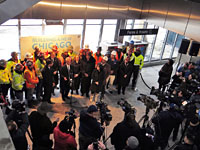
Chicago Mayor Rahm Emanuel speaks at the opening ceremony for the Cermak-McCormick Place station on February 9, 2015. For a larger view, click here. (Photo by Graham Garfield) |
The new station was expected to be completed by the end of 2014,26 but was later rescheduled to open in early 2015. Subzero temperatures in early 2014 were blamed for the delay, and according to Chicago Department of Transportation spokesman Pete Scales, the construction schedule was adjusted to minimize neighborhood traffic and Green Line disruptions.27 "Last winter was pretty brutal when we were doing the work to support the foundations for the tube structure. The drill rigs were freezing up left and right," Cliff Olszewski, resident engineer for H.W. Lochner, Inc., a construction manager on the project, said two days before the station's opening.28
Local alderman Pat Dowell noted that 3rd Ward residents spent 5,000 hours building the new station and that 50 percent of the work was done by Chicago residents. Mayor Rahm Emanuel praised Dowell for insisting that area residents were involved -- not just in using the station, but building it.29
The Cermak-McCormick Place station opened for service at 5am, Sunday, February 8, 2015. A dedication ceremony was held at the station Monday morning, February 9, inside the main station house. Mayor Rahm Emanuel opened the new facility; joining Emanuel at the ribbon-cutting were CTA President Forrest Claypool, Department of Transportation Commissioner Rebekah Scheinfeld, and Ald. Pat Dowell (3rd).
The North-South Route (Temporarily) Returns, Thrice
Red Line service between Howard and Ashland/63rd via the South Side Elevated returned temporarily in 2017, although it was only select trains and only during weekday rush periods; during most times, normal service via the Dan Ryan branch continued. The diversion was necessitated by the $280 million 95th Terminal Improvement Project to expand and greatly improve the 95th/Dan Ryan Red Line station -- as construction continued on the new terminal, including foundations and structural steel work next to the tracks, track alignment work, and platform construction, CTA needed to close both the east and west platform tracks (at separate times), severely constraining capacity during rush and requiring a reduction in the number of trains in and out of the station.
The diverted Red Line trains were rerouted via the old 13th Street Incline from the State Street Subway to the South Side Elevated, where they operated to Ashland/63rd via the South Side Elevated tracks in a pattern reminiscent of the old Howard-Englewood "A" trains of the North-South Route days.
On April 3, 2017, CTA began rerouting some Red Line trains, primarily in the off-peak direction, for a few hours each weekday onto the Green Line to or from the Ashland/63rd station. Reroutes onto the south Green Line in the off-peak direction took place in the morning (7:56 to 9:14am) and evening (4:40 to 5:58pm) rush periods (times at Roosevelt, just north of the diversion point); there were also a small number of trains that operated between Ashland/63rd and Howard in the peak direction, though primarily for car-balancing purposes. CTA officials said the reroute affected less than 10 percent of all Red Line trains.
The diversion of select rush period Red Line trains to/from Ashland/63rd lasted for approximately six months, with the last Howard-Ashland/63rd trains running Wednesday evening, November 22, 2017.
The Red Line Ashland/63rd service resumed on July 30, 2018, to allow additional work in, over and around the platform tracks at 95th/Dan Ryan; the last day of this iteration of the service last ran on April 26, 2019.
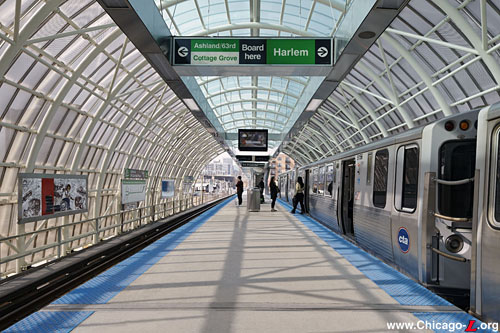
The island boarding platform at Cermak-McCormick Place station is seen looking north as a Harlem-bound Green Line train boards and alights passengers on September 17, 2015. The vaulted shed-type canopy provides a column-free platform, which helps improve circulation space on what would otherwise be a somewhat narrow platform, and -- along with the translucent roof panels overhead and mesh metal panels on the sides -- gives the space an open, lighter feel. For a larger view, click here. (Photo by Kate Joyce Studios, courtesy of CDOT) |

Old Cermak Station (1892-1977) | New Cermak-McCormick Place Station (2013-present)
Old Cermak station (1892-1977)
New Cermak-McCormick Place station (2013-present)
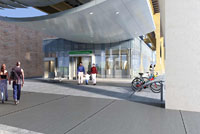 |
cermak-mccormickplace-rendering02.jpg (157k)
An artist's rendering shows the main entrance to the new Cermak-McCormick Place station, looking north on the north side of Cermak Road. The full-height glass curtain walls of the station house, polished, curved metal canopy over the entrance approach, and stylized street furniture give the facility a decidedly modern feel. Compare with a similar view of the built station. (Rendering courtesy of CDOT) |
 |
cermak-mccormickplace-rendering03.jpg (250k)
An artist's rendering shows the design for the Cermak-McCormick Place station platform, looking south. With the platform width being somewhat narrow, fitting where a center track formerly was, an almost completely unobstructed environment was designed, with full-enclosed weather protection provided by a tubular canopy with skylights for daytime illumination and lights and signs suspended from above. Compare with a similar view of the built station. (Rendering courtesy of CDOT) |
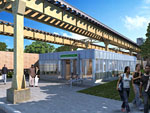
|
cermak-mccormickplace-rendering04.jpg (251k)
The auxiliary entrance to the new Cermak-McCormick Place station at 23rd Street is shown in an artist's rendering, looking northwest. The building has the same modern styling as the main entrance, with full-height glass curtain walls and steel fixtures and cornice, albeit on a smaller scale. (Rendering courtesy of CDOT) |
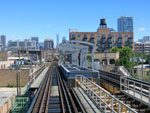 |
cermak-mccormickplace01.jpg (266k)
Steel for the north end of the new Cermak-McCormick Place station platform's deck, canopy and elevator tower are well along being installed in this view looking north on July 2, 2014. (Photo by Graham Garfield) |
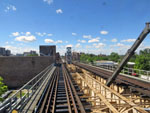 |
cermak-mccormickplace02.jpg (224k)
That the platform for the Cermak-McCormick Place station was built in a space formerly occupied by a third, middle track on the South Side elevated is evident in this view looking south on July 2, 2014. The steel of the south elevator tower is visible in the distance; a section of the elevated structure that formerly supported the middle track has been removed to allow the stairways from the platform to the south Cermak and 23rd Street entrances to eventually be installed. (Photo by Graham Garfield) |
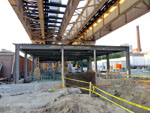 |
cermak-mccormickplace.23rd01.jpg (247k)
The foundation and steel framework for the 23rd Street entrance to the Cermak-McCormick Place station is in place on July 18, 2014. (Photo by Graham Garfield) |
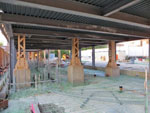 |
cermak-mccormickplace.23rd02.jpg (228k)
The interior of the Cermak-McCormick Place 23rd Street station house is in the process of being built out on July 18, 2014, with rebar criss-crossing the ground in anticipation of the concrete flooring being poured, while utilities have been stubbed in for the planned equipment. The latticed columns for the elevated structure that predate the station were left as-in and simply pierce through the building; note the old "Private property / No trespassing" sign on one column, left from when it stood on open land, next to an alley. (Photo by Graham Garfield) |
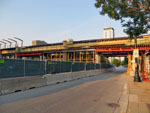 |
cermak-mccormickplace03.jpg (231k)
The elevated structure over Cermak Road is supported by a considerable amount of bracing while it is modified to carry the new Cermak-McCormick Place station, resulting in all but one lane in each direction being blocked, looking east on July 18, 2014. Some of the steel for the canopy at the north end of the platform is visible in the upper left. (Photo by Graham Garfield) |
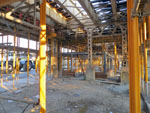 |
cermak-mccormickplace.cermaksouth01.jpg (302k)
The station house on the south side of Cermak Road for the Cermak-McCormick Place station is not as far along as the entrances at 23rd Street or on the north side of Cermak in this July 18, 2014 view, with only basic steel framing in place and the foundation still underway. (Photo by Graham Garfield) |
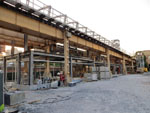 |
cermak-mccormickplace.cermaknorth01.jpg (219k)
The steel structural framing, foundation, and utilities stub-ins are all in place for the Cermak-McCormick Place main station house on the north side of Cermak Road, looking northwest on July 18, 2014, with stacks of material for additional construction already available. (Photo by Graham Garfield) |
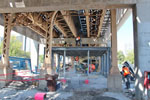 |
cermak-mccormickplace.cermaknorth02.jpg (259k)
Construction of the north entrance for the Cermak-McCormick Place station continues in this view looking north on September 17, 2014, as a number of construction workers labor on various parts of the building. (CTA photo) |
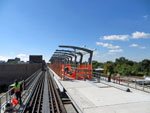 |
cermak-mccormickplace04.jpg (231k)
The installation of precast concrete platform decking at Cermak-McCormick Place is well underway by the time of this September 22, 2014 view looking south. (Photo by Graham Garfield) |
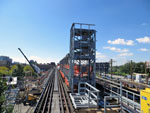 |
cermak-mccormickplace05.jpg (187k)
The platform-level facilities of the new Cermak-McCormick Place station are advancing in this view looking south from north of the station on September 22, 2014, with the steel structures of the north elevator tower and cantilevered canopy nearly complete. Note that a prefabricated section of shed canopy is visible on the ground in the left background, awaiting being lifted into place. (Photo by Graham Garfield) |
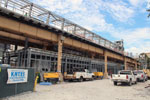 |
cermak-mccormickplace.cermaknorth03.jpg (255k)
Framing for the windows and roof of the Cermak-McCormick Place main station house have been installed as construction on the building continues, looking northwest on September 26, 2014. (CTA photo) |
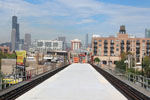 |
cermak-mccormickplace06.jpg (202k)
A September 26, 2014 view looking north on the Cermak-McCormick Place station platform shows the prefabricated decking in place, with grooves down the length of each side for the eventual installation of tactile edging. The steel of the side canopy and elevator at the north end are visible in the distance. (CTA photo) |
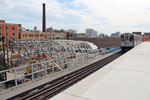 |
cermak-mccormickplace07.jpg (227k)
Prefabricated sections of the shed canopy sit in the staging yard to the east of the Cermak-McCormick Place station site, awaiting being lifted inti place as a Harlem-bound Green Line train passes through on September 26, 2014. (CTA photo) |
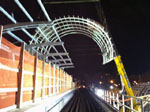 |
cermak-mccormickplace08.jpg (101k)
A crane lifts a section of prefabricated canopy steel from an adjacent lot into place at the Cermak-McCormick Place station early in the morning of October 4, 2014. (CTA photo) |
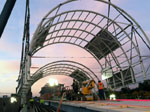 |
cermak-mccormickplace09.jpg (116k)
A second section of prefabricated steel for the Cermak-McCormick Place shed canopy is lifted into place during a linecut early the morning October 4, 2014. Note that a few sections of steel paneling as well as the metal mounting panels for the station name signs and directional line diagram signage is already attached to the canopy steel. (CTA photo) |
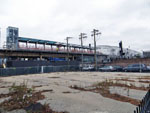 |
cermak-mccormickplace11.jpg (222k)
The Cermak-McCormick Place station is seen looking southeast from State Street in November 6, 2014. The station's structure is now largely complete, with work largely concentrating on applying finishes, fitting and equipment. (Photo by Graham Garfield) |
 |
cermak-mccormickplace12.jpg (210k)
A worker on a scissor lift works on the installation of the translucent roof panels on the Cermak-McCormick Place platform canopy on November 6, 2014. (Photo by Graham Garfield) |
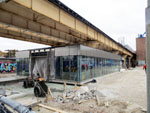 |
cermak-mccormickplace.23rd03.jpg (212k)
The glass and metal cladding and finishes are largely complete on the exterior of the 23rd Street station house at the new Cermak-McCormick Place station, seen looking northwest on November 6, 2014. Work at the headhouse was then concentrated largely inside, installing all the interior equipment and finishes. (Photo by Graham Garfield) |
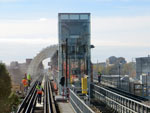 |
cermak-mccormickplace13.jpg (195k)
The Cermak-McCormick Place station is seen under construction, looking south on November 7, 2014. CTA flagmen protect construction workers on the tracks and on the platform. (Photo by Graham Garfield) |
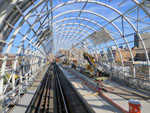 |
cermak-mccormickplace14.jpg (301k)
The platform canopy vault at Cermak-McCormick Place is under construction in this November 7, 2014 view looking north. The canopy structure is in place, lifted into place pre-assembled with certain roofing and signage panels already attached. The work of installing the remaining panels is underway, along with other elements mounted to the structure, which will be put into place with the lifts seen parked on the platform. (Photo by Graham Garfield) |
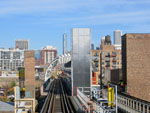 |
cermak-mccormickplace15.jpg (234k)
With the metal cladding applied to the south elevation of the south elevator tower, Cermak-McCormick Place is progressing toward completion in this November 7, 2014 view looking north with the downtown skyline in the background. (Photo by Graham Garfield) |
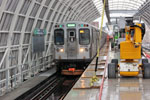 |
cermak-mccormickplace16.jpg (239k)
A Harlem-bound Green Line train passed through the Cermak-McCormick Place station on a rainy December 8, 2014. The lifts parked on the precast concrete platform were being used by crews to work on the overhead canopy and finishes. (Photo by Tony Coppoletta) |
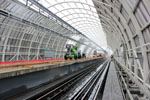 |
cermak-mccormickplace17.jpg (257k)
Work is underway to install the overhead raceways and equipment over the Cermak-McCormick Place island platform, looking north on December 8, 2014. (Photo by Tony Coppoletta) |
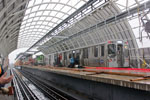 |
cermak-mccormickplace18.jpg (251k)
A Cottage Grove-bound Green Line train passes through the Cermak-McCormick Place station while work continues on the platform and vaulted canopy on December 8, 2014. (Photo by Tony Coppoletta) |
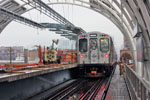 |
cermak-mccormickplace19.jpg (222k)
Green Line Run 601, trailed by car 5103, has been given an express run on its way to Harlem/Lake due to a service delay, but still needed to pass through the under-construction Cermak-McCormick Place station at a reduced speed due to the presence of construction personnel and equipment -- seen at the north end of the station on December 8, 2014. (Photo by Tony Coppoletta) |
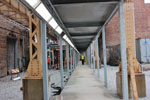 |
cermak-mccormickplace.23rd04.jpg (232k)
The ground-level walkway between the entrances on the south side of Cermak Road and 23rd Street entrances, connecting to vertical access to the Cermak-McCormick Place platform, is seen under construction looking north from near the 23rd station house on December 8, 2014. The walkway, canopy structure and lighting are all in place; just the side panels, signage and some other finishes need to be installed. (Photo by Tony Coppoletta) |
 |
cermak-mccormickplace.23rd05.jpg (240k)
The southernmost stairs between the Cermak-McCormick Place platform and the walkway between the Cermak south and 23rd entrances -- closest to the 23rd Street station house -- is seen rising from the ground to the elevated structure on December 8, 2014. Note how the elevated structure beyond the stairway has spans for the middle track -- now used to support the platform -- which end and were removed to allow the stairs to project through the structure to platform level. (Photo by Tony Coppoletta) |
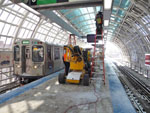 |
cermak-mccormickplace20.jpg (276k)
Construction crews work to complete wiring and other finishing touches in the raceway over the platform -- and other places throughout the station -- at Cermak-McCormick Place as Green Line Run 606 passes through on its way to Harlem on February 5, 2015, about a week before the station opened. (Photo by Graham Garfield) |
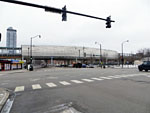 |
cermak-mccormickplace21.jpg (169k)
The completed metal-paneled barrel-vaulted canopy serves as a focal point of the new Cermak-McCormick Place station, seen looking east from the far side of the intersection of Cermak Road and State Street on February 9, 2015, the second day the station was open for service. (Photo by Graham Garfield) |
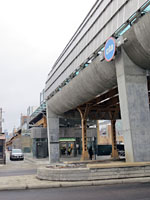 |
cermak-mccormickplace22.jpg (179k)
The Cermak-McCormick Place main entrance station house on the north side of Cermak Road is seen under the elevated track structure from across the wide, divided street on February 9, 2015, while a backlit CTA logo station Identifier mounted in the middle of the structure over the street identifies the station from afar. (Photo by Graham Garfield) |
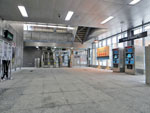 |
cermak-mccormickplace.cermaknorth05.jpg (194k)
The interior of the Cermak-McCormick Place main entrance, on the north side of Cermak Road, is seen looking north in the unpaid area, toward the turnstiles, on February 9, 20150209, its second day of service. The large Building a New Chicago sign and crowd control ropes and stanchions were for a press event for the new station held later that morning. (Photo by Graham Garfield) |
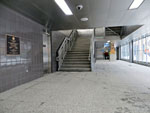 |
cermak-mccormickplace.cermaknorth06.jpg (172k)
The paid area of the Cermak-McCormick Place main station house is seen looking north from just beyond the turnstiles on February 9, 2015. The stairs go up to the platform, with the elevator to the platform visible in the background at the rear of the building. The station's dedication plaque is visible on the left. (Photo by Graham Garfield) |
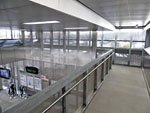 |
cermak-mccormickplace.cermaknorth07.jpg (179k)
While the stairs providing access for entering passengers from the main station house to the Cermak-McCormick Place platform can also be used by exiting customers as well, a second stairway from the north end of the platform provides a second egress pathway out of the station. This exit stairway deposits passengers in front of the station house through a side rotogate-controlled accessway, but takes a scenic pathway through the station house via a mezzanine-level walkway that provides a unique vantage point over the station house interior. The view from the exit gangway is seen on February 9, 2015. (Photo by Graham Garfield) |
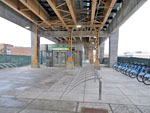 |
cermak-mccormickplace.cermaksouth02.jpg (199k)
The entrance on the south side of Cermak Road to the Cermak-McCormick Place station is seen looking south on February 9, 2015, the second day the station was open. The small secondary entrance, which is designed the same architectural style as the larger main entrance across the street, is set back in a large plaza with rows of racks lining either side to accommodate many parked bikes. Before the station's opening, a Divvy bike sharing station was also added to the plaza. The design of the three steel columns for the elevated structure make evident which two tracks were original, and on which side the third track was added in 1907. (Photo by Graham Garfield) |
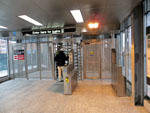 |
cermak-mccormickplace.cermaksouth03.jpg (190k)
The interior of the axillary entrance to Cermak-McCormick Place station on the south side of Cermak Road is seen looking south in the unpaid area on February 9, 2015. The entrance was intended to be unstaffed, so it only has a high-barrier gate (HBG) turnstile. However, it was also originally intended to be an accessible entrance, leading to the south elevator that can also be accessed from the 23rd Street entrance. Because it was to be unstaffed, and an HBG large enough to accommodate a wheelchair would invite fare evasion, a door controlled by fare validator on a turnstile cabinet was the only method to allow entry for wheelchairs. While the door and cabinet were installed, it was decided not to permit entry through this door before the opening, though it could be converted for accessible entry at a later date if desired. (Photo by Graham Garfield) |
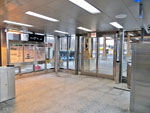 |
cermak-mccormickplace.cermaksouth04.jpg (199k)
Cermak-McCormick Place's south Cermak entrance interior is seen on February 9, 2015, looking northwest in the unpaid area from near the full-height fare control barrier. A transit information panel with maps if the CTA bus and rail system and of the surrounding local area and a timetable for the station are posted on the west wall, under a digital screen showing train arrival times. While an unstaffed auxiliary entrance, the station house also has fare vending machines, the side of one visible on the right. (Photo by Graham Garfield) |
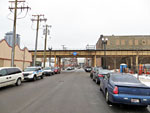 |
cermak-mccormickplace.23rd06.jpg (182k)
A CTA Identifier on the elevated structure marks the location of the 23rd Street entrance to Cermak-McCormick Place, the station house barely visible under the tracks on the left. This scene looks east on East 23rd Street on February 9, 2015. (Photo by Graham Garfield) |
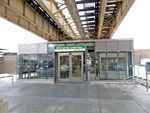 |
cermak-mccormickplace.23rd07.jpg (210k)
The modern glass and steel station house at the 23rd Street entrance to Cermak-McCormick Place is seen looking north on February 9, 2015. The building's design of glass curtain walls with perforated metal upper wall panels and a metal coping is typical of all three station headhouses. Custom-designed bike racks are provided in front. (Photo by Graham Garfield) |
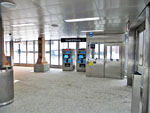 |
cermak-mccormickplace.23rd08.jpg (191k)
The Cermak-McCormick Place 23rd Street entrance's interior is seen on February 9, 2015, looking east in the unpaid area from an alcove next to the doors where the transit information panel is located. The entrance was designed to be able to function unstaffed, but a customer assistant's booth was provided in the design so that it could be staffed if desired. The entrance was staffed when it opened in 2015. Fare vending machines are also provided. (Photo by Graham Garfield) |
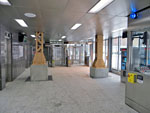 |
cermak-mccormickplace.23rd09.jpg (181k)
The interior of the 23rd Street entrance to Cermak-McCormick Place station is seen looking north in the unpaid area toward the fare controls on February 9, 2015, the second day of service for the station. The customer assistant's booth is in the right foreground. The station house was built where the elevated structure had already existed for over a century, and rather than modify the structure to locate the support columns out of the way, the building was instead built around them, their presence poking through giving the interior an industrial feel. (Photo by Graham Garfield) |
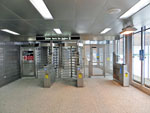 |
cermak-mccormickplace.23rd10.jpg (197k)
The fare controls of the Cermak-McCormick Place 23rd Street entrance are seen on February 9, 2015. Unlike other stations where the entrance is meant to be able ti function in either staffed or unstaffed modes, no normal turnstiles are provided here for use during staffed periods. The entrance has two high-barrier gate (HBG) turnstiles. In addition, because the entrance is accessible but wheelchairs cannot fit in an HBG, a special access door wired into a farecard reader on a turnstile cabinet is also provided. Customers touch their card to the reader like at any other turnstile, then after a few seconds the door automatically opens. Security cameras are provided at the door to try to prevent fare evasion by multiple people going through the door at a time, should the entrance ever be unstaffed. (Photo by Graham Garfield) |
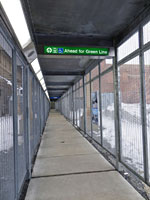 |
cermak-mccormickplace.23rd11.jpg (227k)
A single elevator and two sets of stairs between ground level and the Cermak-McCormick Place platform provide access from two entrances a block away from one another, at the south side of Cermak Road and at 23rd Street. The vertical access paths are located mid-block, requiring enclosed walkways within the paid space of the station between the entrances and the stairs and elevator. One can also simply walk between entrances, if desired. The ground-level walkway, located under the elevated track structure, is seen looking north from near the 23rd entrance on February 9, 2015. (Photo by Graham Garfield) |
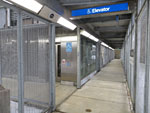 |
cermak-mccormickplace.23rd12.jpg (212k)
The south elevator at Cermak-McCormick Place station, located in a short side hall of the ground-level corridor between the south Cermak and 23rd entrances, is seen looking north on February 9, 2015. The southern of two stairways between the corridor and the platform is visible in the distance. (Photo by Graham Garfield) |
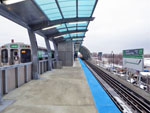 |
cermak-mccormickplace23.jpg (195k)
While the entire Cermak-McCormick Place station platform is between the two Green Line tracks, only the middle portion is functionally an island platform, with trains berthing on both sides. The outer portions of the platform, needed to provide eight cars of platform length, are single-sided, with train access on one side and a back railing along the other. This effectively makes the platform berthings in each direction somewhat offset from each other, though only when longer trains are being run. These single-sided end sections are also where the stairs come up to the platform, allowing the stairs to not overly impede the circulation space on what is otherwise not a terribly-wide platform. The single-sided portion at the north end of the platform is seen looking south toward the main section on February 9, 2015, as a Harlem-bound train leaves the station behind the railing. (Photo by Graham Garfield) |
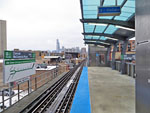 |
cermak-mccormickplace24.jpg (222k)
The far north end of the Cermak-McCormick Place station platform is seen looking north on February 9, 2015, with the elevator down to the main station house on the north side of Cermak Road visible in the background. The two elevators at either end of the station are positioned at the far ends of the platform. (Photo by Graham Garfield) |
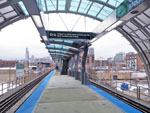 |
cermak-mccormickplace26.jpg (242k)
At Cermak-McCormick Place, the station's trademark arched canopy covers the middle section of the station platform, but the outer ends are covered by a simpler cantilevered canopy supported by a row of columns along its rear, typical of platform canopies at many side platform "L" stations, especially older ones. These outer portions of the platform are where the stairs and elevators between the platform and the station houses are, as well as being used to berth longer trains. The cantilevered canopy at the north end of the Cermak platform is seen from beyond the end of the vaulted covering on February 9, 2015. (Photo by Graham Garfield) |
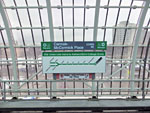
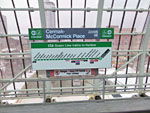 |
cermak-mccormickplace27.jpg (226k)
cermak-mccormickplace28.jpg (243k)
The Cermak-McCormick Place station platform features large directional line diagram signs outboard of the platform to aid in passengers' wayfinding and navigation, helping them to assure choosing the correct side to board on. An example of each direction's line diagram sign is seen on February 9, 2015. The Harlem-bound sign was modified soon after Cermak opening due to the closure of Madison/Wabash a a short time later. The directional line diagrams used at Cermak are the same size -- 144" long and 48" tall -- used in the subway, where they are mounted on the tunnel wall. Because of their size, this type is not typically used outside of the subway -- other versions of the diagram signs are used instead -- due to the challenge of mounting them. However, the barrel-vaulted canopy and its steel structure provide ample support to mount these sizable, legible wayfinding signs. (Photo by Graham Garfield) |
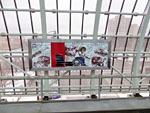
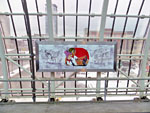
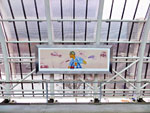
|
cermak-mccormickplace29.jpg (229k)
cermak-mccormickplace30.jpg (258k)
cermak-mccormickplace31.jpg (328k)
New and renovated "L" stations feature sizable art installations, and Cermak-McCormick Place is no exception. Alternating with ad panels and directional line diagram wayfinding signs, eight graphic panels commissioned from a local artist adorn the tube-like canopy structure, facing the boarding platform. Rising Chicago-based artist Hebru Brantley was chosen from a pool of artists who presented proposals for the art component of the "L" station project. The station is located adjacent to the historic Motor Row District -- a historic area built between the 1900s and 1930s that was formerly home to numerous auto showrooms, dealerships, and repair shops -- and Brantley used his signature characters Fly Boy and friends to tell the rich history of Motor Row, combining art and storytelling. (Photo by Graham Garfield) |
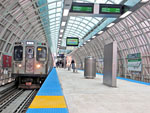 |
cermak-mccormickplace32.jpg (243k)
Green Line Run 005 stops under the arched vaulted canopy at Cermak-McCormick Place on its way to Cottage Grove on February 9, 2015. Train arrival screens, digital advertising screens, and wayfinding signage alternate overhead on the platform. (Photo by Graham Garfield) |
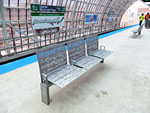 |
cermak-mccormickplace33.jpg (233k)
Even the benches at the Cermak-McCormick Place were given thought and attention. This bench on the platform, seen on February 9, 2015, features a perforated design that mimics the metal panels on the sides of the arched canopy. (Photo by Graham Garfield) |
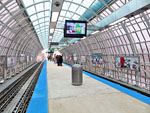 |
cermak-mccormickplace34.jpg (279k)
The island platform at Cermak-McCormick Place is seen looking south on February 9, 2015, the day after the station opened. The platform takes up the space formerly occupied by a third, middle track, and as a result is only 14-feet wide, much narrower than the 22-foot width the CTA's standards specify. Besides having the berthing spaces in each direction a little offset, this is compensated for by use of the tube-like vaulted canopy -- by having the canopy supported outside the tracks rather than by columns and eliminating the need for windbreaks, the absence of these elements allows nearly all the platform space to be used for circulation and waiting. Even the lighting and much of the signage is integrated into a set of raceways running the length of the platform, near the edges, suspended from above. (Photo by Graham Garfield) |
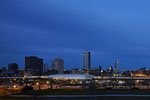 |
cermak-mccormickplace36.jpg (121k)
The perforated metal panels covering the station's tube-like canopy make the Cermak-McCormick Place station glow in the reflected light in this view looking east as the sun sets over the Near South Side on September 17, 2015. (Photo by Kate Joyce Studios, courtesy of CDOT) |
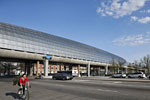 |
cermak-mccormickplace38.jpg (175k)
Cermak-McCormick Place station's distinctive metal-paneled tubular arched canopy dominates this view of the station's platform spanning Cermak Road, looking southeast on September 17, 2015. A CTA Identifier, whose function is to identify the station and act as a beacon from 1-2 blocks away -- normally a fairly substantial-sized element unto itself -- is dwarfed by the massive canopy vault. The scene demonstrates the multimodality of the station and its environs, with an eastbound #21 bus stopping in front of the station's auxiliary entrance across the street, while several bicyclists ride by the station, which features racks for bike parking as well as a bike sharing station. (Photo by Kate Joyce Studios, courtesy of CDOT) |
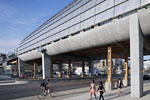 |
cermak-mccormickplace39.jpg (204k)
The many structures of the Cermak-McCormick Place station are visible in this view looking north across Cermak Road on September 17, 2015. The large steel-reinforced tapered concrete columns built as part of the project actually only carry the new arched platform canopy; they don't support the elevated track structure, whose original steel columns are still present and visible. The perforated metal panels on the canopy are attached in a shingle-like arrangement. The main entrance station house on the north side of Cermak Road is visible under the elevated structure, across the street. (Photo by Kate Joyce Studios, courtesy of CDOT) |
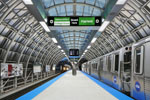 |
cermak-mccormickplace40.jpg (307k)
A Harlem-bound Green Line train is stopped at the Cermak-McCormick Place station platform while a Cottage Grove-bound train enters the station in this dusk view looking north under the station's vaulted canopy on September 17, 2015. (Photo by Kate Joyce Studios, courtesy of CDOT) |
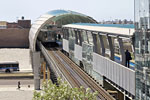 |
cermak-mccormickplace41.jpg (245k)
This view of the Cermak-McCormick Place station shows a view of the facility rarely seen by passengers -- from behind one of the side-loaded sections of platform at the ends of the station. This view of the north end of the station, looking south on September 17, 2015, shows the opposite track (in this case, the northbound track) leaving the station behind the back railing of one of these sections whose front faces the opposite track -- in essence, it is a side platform that backs up to the other track. Beyond it is the arched canopy over the center section of the station where trains in both directions berth. (Photo by Kate Joyce Studios, courtesy of CDOT) |
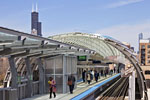 |
cermak-mccormickplace42.jpg (194k)
The tube-like canopy of the Cermak-McCormick Place station is seen giving complete, full-width coverage to the center section of the platform in this view looking north on September 17, 2015, with the Willis (nee Sears) Tower dominating the downtown skyline in the background. The full-height enclosure at the end of the cantilevered canopy, just before the arched canopy, weather-protects the stairs down to street level closest to the entrance/exit on the south side of Cermak Road. (Photo by Kate Joyce Studios, courtesy of CDOT) |
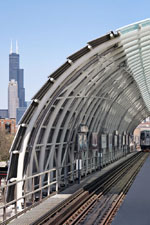 |
cermak-mccormickplace45.jpg (271k)
A detail view of the west side of the Cermak-McCormick Place canopy shows the station's distinctive structure's metal skeleton and arrangement of perforated metal panels cladded the sides and top in a shingle-like pattern. Attached to the canopy structure, opposite the platform, are an alternating series of advertising panels and directional line diagram signs -- both of which have station name signs above them -- as well as art panels. (Photo by Kate Joyce Studios, courtesy of CDOT) |
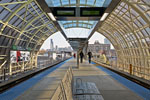 |
cermak-mccormickplace46.jpg (260k)
A view looking north up the Cermak-McCormick Place island platform under the station's arched canopy shows the distinctive vault's translucent polycarbonate roofing over the top and metal panels down the sides, and overhead lighting, screens and signage, revealing the side-loading, cantilevered-canopy platform extension at the far end of the station beyond. (Photo by Kate Joyce Studios, courtesy of CDOT) |
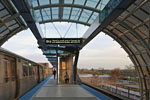 |
cermak-mccormickplace47.jpg (203k)
A passenger ascends the stairs from the entrance on the south side of Cermak Road to the Cermak-McCormick Place station platform as a Green Line train toward Harlem terminal enters the station on September 17, 2015, viewed from the south end of the station's vaulted canopy. The stairs to the 23rd Street exit and the elevator are beyond, obscured by the enclosure around the closest stairway. (Photo by Kate Joyce Studios, courtesy of CDOT) |
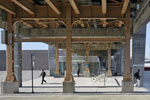 |
cermak-mccormickplace.cermaksouth05.jpg (205k)
The smaller auxiliary entrance station house for Cermak-McCormick Place station on the south side of Cermak Road is seen through the jungle of vertical support columns from various eras on September 17, 2015. The view clearly shows that the older steel columns supporting the steel elevated track structure and the new concrete columns supporting the new platform canopy are independent from one another. (Photo by Kate Joyce Studios, courtesy of CDOT) |
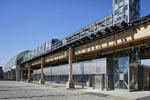 |
cermak-mccormickplace48.jpg (206k)
The east elevation of the long main station house for the Cermak-McCormick Place station is seen under the elevated track structure, anchored by the north elevator tower at its far end, looking south on September 17, 2015 as a Green Line train leaves the station. The lot next to the station is vacant, which aided construction, but would likely not stay that way as the neighborhood redevelops, aided by the convenience of the new transit station. (Photo by Kate Joyce Studios, courtesy of CDOT) |
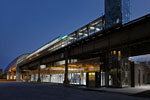 |
cermak-mccormickplace49.jpg (153k)
The same view as above is seen at night, dramatically illuminated by the station's internal lighting. (Photo by Kate Joyce Studios, courtesy of CDOT) |
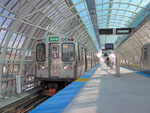 |
cta5078.jpg (261k)
A train of CTA's newest cars pulls into CTA's newest, most modern station, as Harlem-bound Green Line run 013, lead by 5000-series car 5078, stops at Cermak-McCormick Place in spring 2015. (Photo by Corey Ellison) |
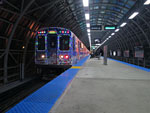 |
cta2894-HolidayTrain2015b.jpg (193k)
The CTA Holiday Train, with car 2894 in the lead, stops at the Cermak-McCormick Place station during the stop's first holiday season in operation, looking south on December 1, 2015 as the train heads toward Harlem/Lake. (Photo by
Corey Ellison) |
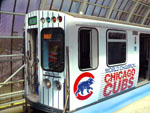 |
cta5303-Cubs02.jpg (304k)
The front end of Cubs World Series-wrapped car 5303 leads a charter train (contrary to what its Green Line destination sign would suggest) at Cermak-McCormick Place station on April 23, 2017. The white cars feature dark blue pinstripes on the end cap, reminiscent of the Cubs' home uniforms. Under the left side window of each car is the team's alternate/secondary logo, commonly referred to as the "Crawling Cub logo"; the team's primary logo (the red "Cubs" with the large "C" inside a blue circle) is at the right end of each car. (Photo by David Harrison) |

Notes:
1. Spielman, Fran. "Parking increase to fund new Cermak L station, downtown express bus service." Chicago Sun-Times. 14 October 2011.
2. Hinz, Greg. "City plans McCormick Place el station." chicagobusiness.com. 14 October 2011.
3. Spielman, ibid.
4. Hinz, ibid.
5. "Mayor Emanuel Opens Newly-Renovated Grand Avenue Red Line Station." City of Chicago press release, January 17, 2012.
6. Ibid.
7. Meyerson, Ben. "Morgan 'L' designer will take on Cermak." Chicago Journal. 30 May 2012.
8. Meyerson, Ben. "Details emerge on Cermak Road Green Line station." Chicago Journal. 23 March 2012.
9. Cox, Ted. "CTA Breaks Ground on New Cermak-McCormick Place Station." DNAinfo Chicago, August 29, 2013.
10. Spielman, Fran. "Ground to be broken for new $50 million CTA Green Line station near McCormick Place." City Hall Early & Often blog. Voices: Sun-Times, August 29, 2013.
11. Hilkevitch, Jon. "Long-awaited Cermak-McCormick Place Green Line station opens." Chicago Tribune, February 9, 2015.
12.
Meyerson (2012), ibid.
13. Spielman (2011), ibid.
14. Vance, Steven. "Ross Barney Express." The Architects Newspaper, February 20, 2015.
15. Spielman, Fran. "City hopes Green Line station brings life to McCormick Place area." Chicago Sun-Times, August 29, 2013.
16. Vance, ibid.
17. Ibid.
18. Hilkevitch, ibid.
19. Ibid
20. Ibid.
21. "Mayor Emanuel Announces Opening of New Cermak CTA Green Line Station." CTA press release, February, 9, 2015
22. Mckissick, Ciera. "CTA Unveils Hebru Brantley Artwork in New Green Line Station." Newcity, February, 20, 2015.
23. City of Chicago, "Mayor Emanuel Breaks Ground for Cermak Avenue Green Line Station,"August 29, 2013.
24.
Harrison, Kyle. "New Construction Permit: $41.3M South Loop CTA construction project." Chicago Development News. October 10, 2013.
25.
Hilkevitch, ibid.
26.
City of Chicago (20130, ibid.
27. Swartz, Tracy. "McCormick Place Green Line opening delayed to early 2015: city." RedEye, December 3, 2014.
28.
Hilkevitch, ibid.
29. Spielman, Fran and Mitch Dudek. "New Green Line station open near McCormick Place," Chicago Sun-Times, February 9, 2015.


















